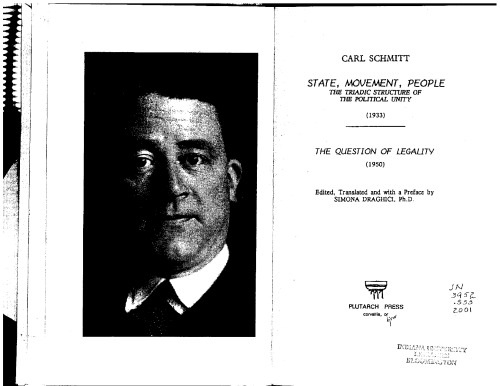State Movement People The Triadic Structure of the Political Unity 1933 The Question of Legality 1950 1st Edition by Carl Schmitt ISBN 0943045185 9780943045184 by Carl Schmitt 9780943045184, 0943045185 instant download after payment.
State Movement People The Triadic Structure of the Political Unity 1933 The Question of Legality 1950 1st Edition by Carl Schmitt - Ebook PDF Instant Download/Delivery: 0943045185, 9780943045184
Full download State Movement People The Triadic Structure of the Political Unity 1933 The Question of Legality 1950 1st Edition after payment

Product details:
ISBN 10: 0943045185
ISBN 13: 9780943045184
Author: Carl Schmitt
"State, Movement, People" (1933) stands as a stark testament to Schmitt's immediate engagement with the Nazi seizure of power. Written in the very year Hitler became Chancellor, this work sought to provide a theoretical and jurisprudential framework for the National Socialist state. In it, Schmitt attempts to describe and legitimize a new form of political unity, moving beyond the traditional liberal state. He posited a "triadic structure" where the State (as the formal legal and administrative apparatus), the Movement (specifically the Nazi Party, embodying the dynamic, ideological, and driving force), and the People (the Volk, understood as a racial and existential unity) were fused into an organic whole. This configuration aimed to overcome the perceived fragmentation and impotence of the Weimar Republic, offering a vision of a unified, decisive, and racially homogeneous political entity. The essay is deeply implicated in Schmitt's efforts to align his legal theory with the nascent Nazi regime, arguing for a "total state" that transcended mere legal formalism to embrace a substantive, völkisch unity
State Movement People The Triadic Structure of the Political Unity 1933 The Question of Legality 1950 1st Table of contents:
Part I: Setting the Stage: Defining Rurality and Emerging Trends
- Chapter 1: The Evolving Definition of Rural America
- Statistical vs. Perceptual Rurality
- Diversity Within Rural Landscapes (e.g., Amenity-Rich, Agricultural, Industrial)
- Historical Context: Transformations of the 20th Century
- Chapter 2: Globalization and the Rural Economy
- Impact of Global Markets on Agriculture and Manufacturing
- The Decline of Traditional Resource Industries
- New Economic Niches and the Service Economy
- Chapter 3: Demographic Shifts in Rural America
- Out-migration of Youth and Brain Drain
- Aging Populations and Their Consequences
- Changing Ethnic Composition (e.g., Latino migration to new rural destinations)
- The "Exurban" Fringe and Rural-Urban Interdependence
Part II: Key Socio-Economic Challenges
- Chapter 4: Economic Restructuring and Diversification
- Job Creation and Entrepreneurship in Rural Areas
- Challenges of Small Business Development
- The Role of Tourism and Recreation Economies
- Poverty and Income Inequality in Non-Metropolitan Areas
- Chapter 5: Access to Education and Human Capital Development
- Challenges for Rural Schools (Funding, Teacher Recruitment, Curriculum)
- Post-Secondary Education and Workforce Training in Rural Settings
- Bridging the Digital Divide for Educational Opportunities
- Chapter 6: Rural Healthcare Access and Disparities
- Shortage of Healthcare Professionals and Facilities
- Health Outcomes and Chronic Disease in Rural Populations
- Mental Health Services and Substance Abuse Challenges
- Telemedicine: Promise and Limitations (as of 2002)
Part III: Infrastructure, Environment, and Governance
- Chapter 7: Infrastructure Gaps: Broadband, Transportation, and Utilities
- The Broadband Imperative for Rural Competitiveness
- Maintaining and Upgrading Rural Transportation Networks
- Access to Reliable Water, Sewer, and Energy Services
- Chapter 8: Natural Resources and Environmental Stewardship
- Balancing Economic Development with Environmental Protection
- Land Use Conflicts and Sprawl
- Water Scarcity and Quality Issues
- The Role of Rural Communities in Conservation and Renewable Energy
- Chapter 9: Governance and Community Capacity
- Challenges of Local Government in Declining Areas
- Leadership Development in Rural Communities
- Building Social Capital and Civic Engagement
- Inter-local Cooperation and Regional Planning
Part IV: Policy Responses and Future Outlook (from a 2002 Perspective)
- Chapter 10: Federal and State Policy Frameworks for Rural Development
- Historical Policies and Their Effectiveness
- Agriculture Policy and Its Broader Rural Impact
- Challenges of Targeting Rural Aid
- The Role of Research and Extension Services
- Chapter 11: Community-Led Initiatives and Local Solutions
- Examples of Successful Rural Revitalization Efforts
- Grassroots Innovations and Self-Reliance
- The Importance of Place-Based Approaches
- Chapter 12: Looking Forward: Prospects for Rural America in the 21st Century
- Synthesis of Enduring and Emerging Challenges
- Opportunities for Resilience and Adaptation
- The Continuing Importance of Rural-Urban Linkages
- Key Areas for Future Research and Policy Focus
People also search for State Movement People The Triadic Structure of the Political Unity 1933 The Question of Legality 1950 1st:
state movement people the triadic structure of the political unity
what is triadic structure
structure of social movement
is triadic structure language or structure
structure of tribal government
Tags: Carl Schmitt, State, Triadic



